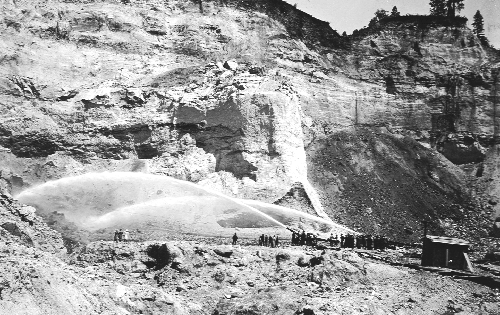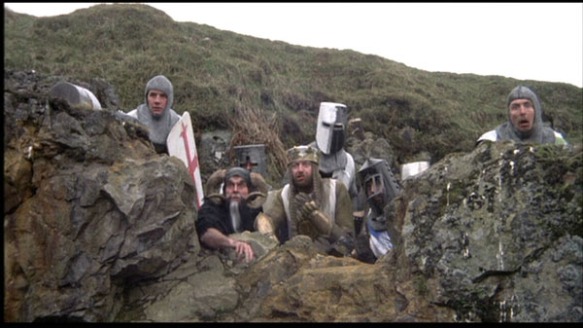Joseph Campbell considered the Wasteland and the quest for the Grail that heals it to be a core myth for our time. During “The Power of Myth” series at the end of his life, Campbell said the Wasteland results from a worldview that divides matter and spirit. Referring to the Fisher King’s wound he said:
“the Christian separation of matter and spirit…has really castrated nature. And the European mind, the European life, has been, as it were, emasculated by this separation. The true spirituality, which would have come from the union of matter and spirit, has been killed.” (1)
Generations of western thinkers, culminating in Descartes, built upon the split Campbell cites to elaborate a mechanistic view of nature that made the world ripe for human exploitation. Results of this world view are visible everywhere, both in the headlines and in the landscape around us. This part of California, for instance, still bears the scars of hydraulic mining 150 years after the gold rush.
Deliberate exploitation isn’t always the culprit. We think of Native Americans as attuned with nature, but even they made mistakes. From AD 900-1150, such a large concentration of Pueblo people lived in Chaco Canyon, NM that they cut an estimated million trees from the surrounding Colorado Plateau. The resulting erosion, loss of game habitat, and flooding is thought to be one reason why they abandoned the site. The surrounding landscape, once forest, has been desert ever since.
Now that humans have the power to disrupt the environment on a global scale, the question of whether the harm is deliberate or inadvertent may be moot, but serious differences still lie at the heart of competing world views. Campbell touched on this issue in Creative Mythology, the last book of The Masks of God, a four volume study of world mythology that he wrote between 1962 and 1968. In this series, he ascribed four functions to myth (2)
- The Metaphysical Function: Awakening a sense of awe before the mystery of being
- The Cosmological Function: Explaining the shape of the universe
- The Sociological Function: Validate and support the existing social order
- The Pedagogical Function: Guide the individual through the stages of life
The Grail story resonates on all of these levels, but since I want to consider the Wasteland myth in light of our current environmental crisis, the third and fourth functions have the greatest relevance here.
Campbell points out that humans are born too soon, “absolutely helpless,” and unlike most other animals, learn how to survive from a social group. Our earliest myths derive from the hunter/gatherer era, “hardly greater than large families, of which every adult member was in possession of the entire cultural heritage.”
These earliest myths “served a fostering, educative function, bearing the unfinished nature product to full, harmonious unfoldment as an adult specifically adapted for survival in a certain specific environment, as a fully participating member of a specific social group; and apart from that group he would neither have come to maturity nor have been able to survive.” There was room for diversity, but no one who threatened the group was tolerated.
The next strata of myth emerged when humans settled into agricultural communities, beginning around 7500 B.C.. Villages grew into towns and then into cities and “it was precisely at this point of space and time, in the Near East, and specifically Sumer, c. 3500-3000 B.C., that the evidence first appears among the ruins…first, of a disciplined social order imposed from above by force, and next, of deliberate expeditions of military conquest against neighbors…campaigns of systematic conquest and subjugation.” The principle here, said Campbell, was “greed for more than one’s share.”
Imposed social orders are not inherently bad, says Campbell. Despite romantic fantasies of the noble savage, few people really want to live in caves or give up such boons as advanced medicine, arts, spirituality, and transportation, to say nothing of indoor plumbing. Like conventions in writing, music, or painting, cultural conventions may spark creativity when they are new and later stifle it as they atrophy.
“The Waste Land, let us say then, is any world in which…force and not love, indoctrination not education, authority not experience, prevail in the ordering of lives, and where the myths and rites enforced and received are consequently unrelated to the actual inward realizations, needs, and potentialities of those upon whom they are impressed.”
This was the situation when the European Grail myth emerged; the first written version was composed in the 12th century by Cretien de Troyes at the very time the inquisition began. The Grail legend served as a counterpoint to the institutional church; the tale can be read as the map of a quest for personal realization, safely couched in a story of ladies and knights. In the earliest versions, the Grail was not the cup of the last supper but a stone or a large stone dish, which like the philosopher’s stone of alchemy, granted the heart’s deepest desire.
Even at our remove from the middle ages when the stories emerged, the Grail remains one of our living myths, at least if you pay attention to popular fiction and movies. Think of The Da Vinci Code, Indiana Jones and the Last Crusade, and even Monty Python and the Holy Grail.
As much as the population of the middle ages, we are, in the words of 19th century poet, Matthew Arnold, “Wandering between two worlds, one dead, the other powerless to be born.” The Grail continues to speak to such eras, especially one in which the Wasteland is not just the metaphor of an inner desert, but a world in which that desert is visible around us.
The Grail remains a shining image, never quite clear, but unforgettable, of the kind of life and world we seek among the confusion of possible futures. At the end of “The Power of Myth” series, Bill Moyers asked Joseph Campbell what the myth of the future might be.
“You can’t predict a myth anymore than you can predict what you’re going to dream tonight,” Campbell replied (3). “Dreams and myths come from the same place.” Then he went on to say, “The only myth that’s going to be worth thinking about in the immediate future is going to be one that is talking about the entire planet.”
“You don’t see any divisions there of nations or states. This may be the symbol of the mythology to come. That’s going to be the country we are celebrating.” – Joseph Campbell, 1987″
Next: Some people who are already question for the Grail.





The myth of the future is already here. It’s the humanist vision of man’s redemption through technology. I live near silicon valley where the high priests of this cult dwell.
LikeLike
I’ve spent chunks of my life in Silicon Valley and live fairly close now. Also spent most of my working life at one of the big name corporations. At the time I started, when I was an enthusiastic young nerd with a Commodore 64, maybe that was true. But I think now with the NSA revelations, and when everyone finds that their geek gear has made life busier and more hectic than ever, that myth is a bit frayed about the edges. Or perhaps we could say the high priests have discovered technological original sin?
One of the possible futures, definitely, but not the one I think most people long for these days.
LikeLike